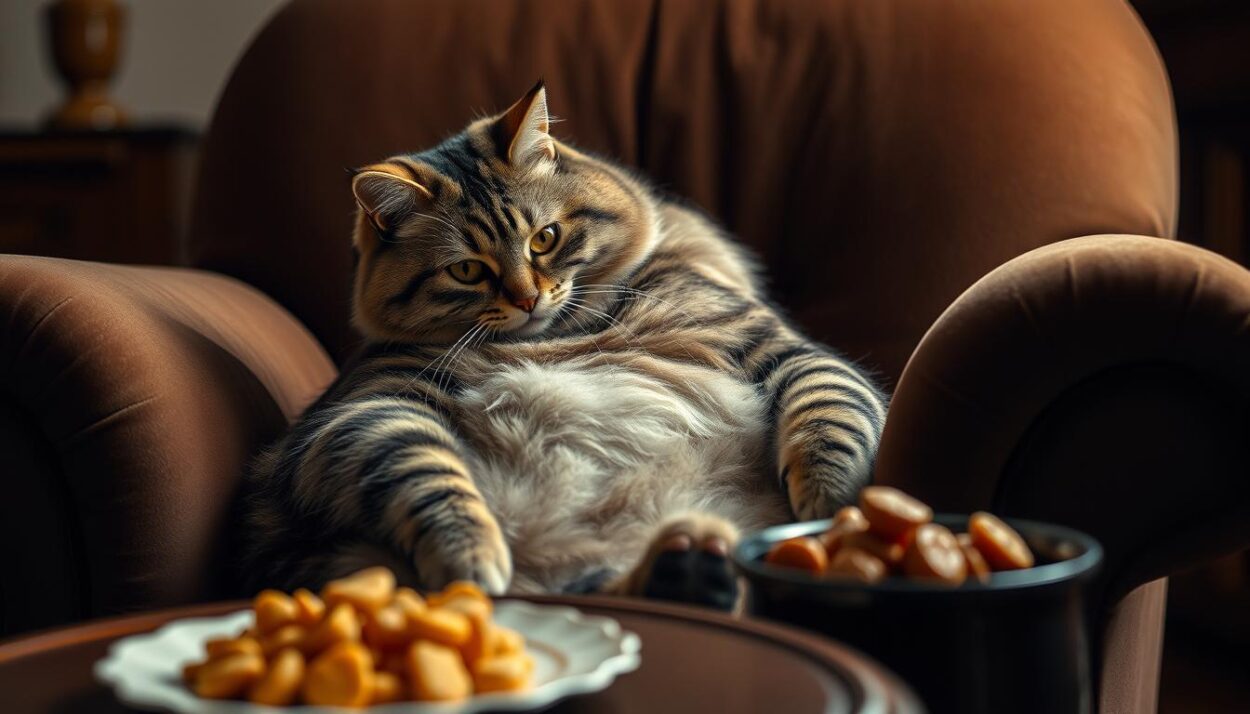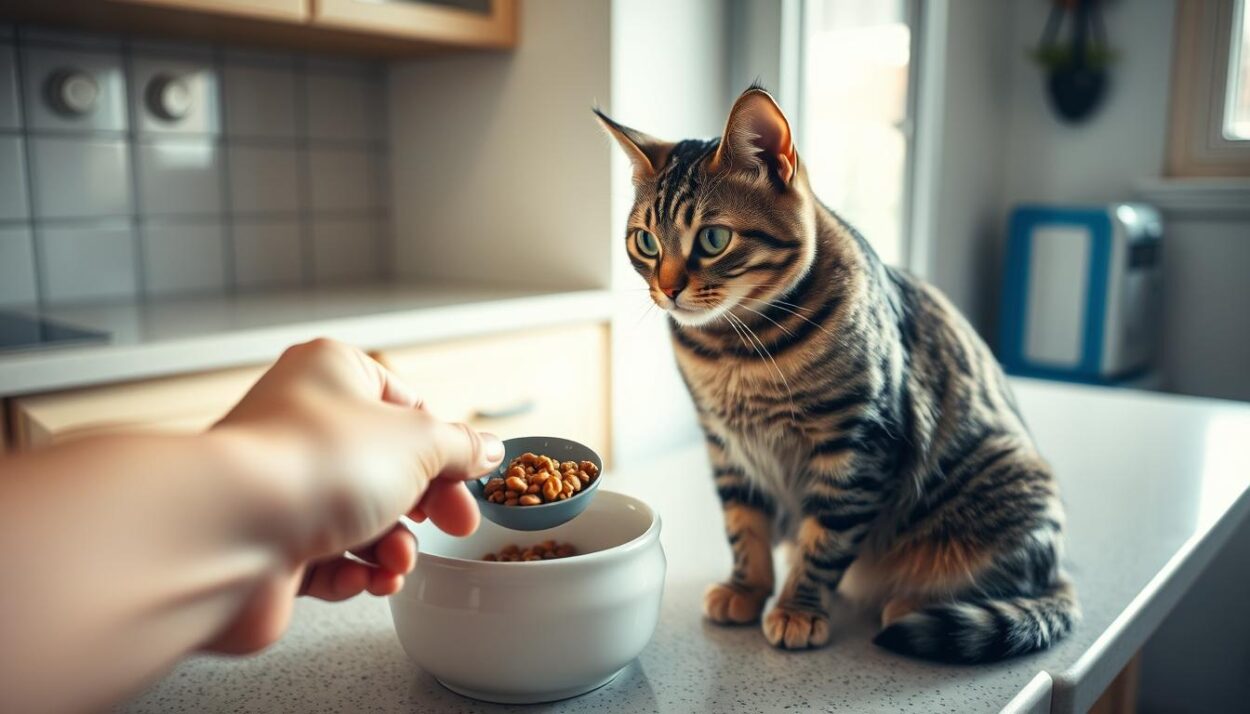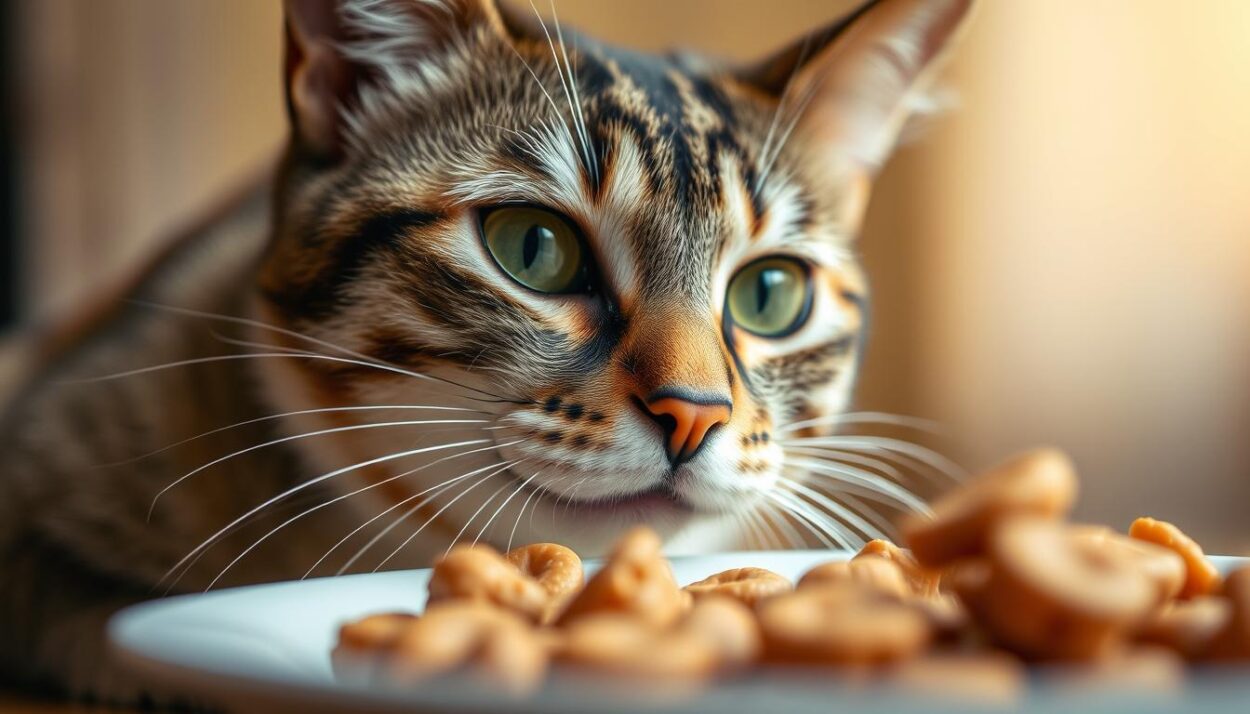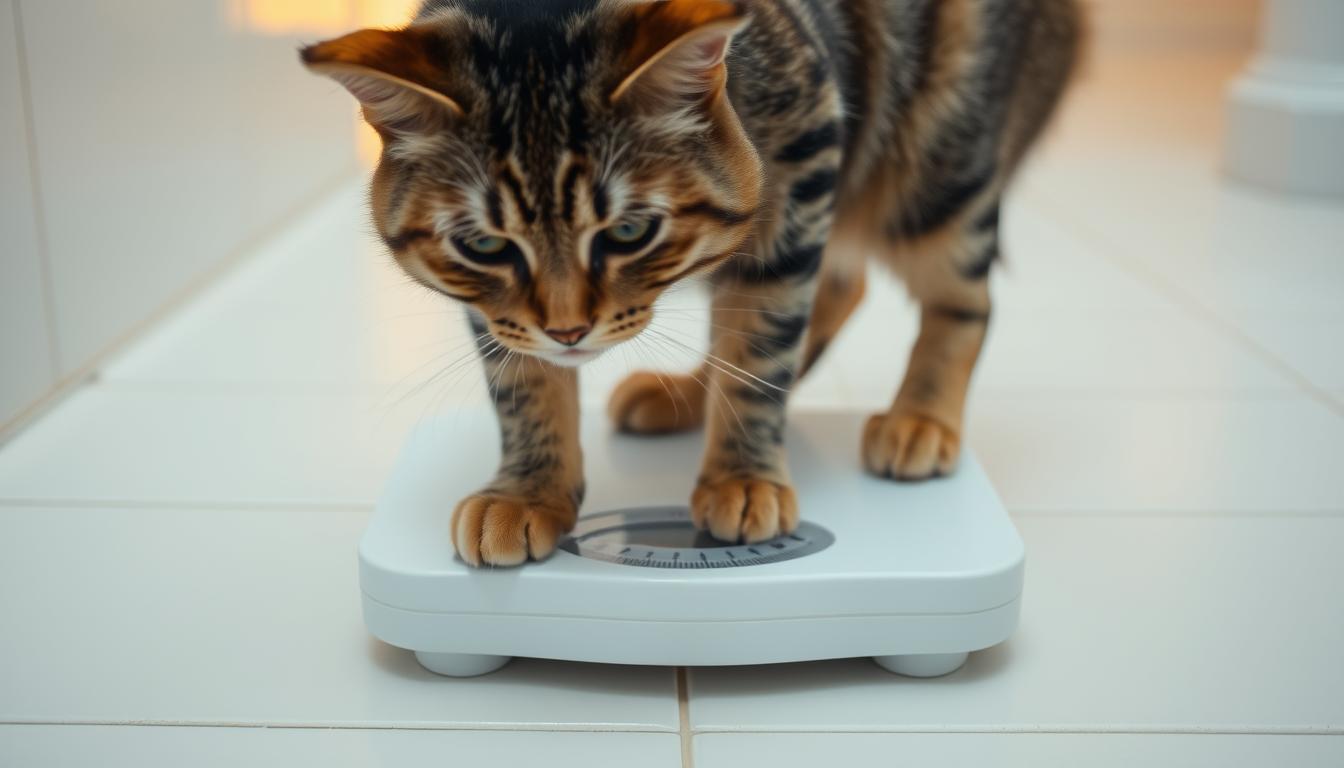When Sarah noticed her tabby, Milo, picking at his meals, she assumed it was a passing phase. Weeks later, his ribs became visible under his once-glossy coat. A veterinary visit revealed Milo had developed hyperthyroidism—a condition affecting 10% of senior cats, according to WSAVA research. This scenario highlights how subtle changes in a pet’s physique often signal deeper health concerns.
Monitoring a feline’s body condition requires regular visual and tactile checks. A healthy cat typically maintains a defined waistline and a slight fat layer over the ribs. Unexpected weight fluctuations—whether loss or failure to gain—may indicate issues ranging from intestinal parasites to metabolic disorders.
Veterinary studies emphasize that nutritional imbalances and medical conditions often intertwine. For instance, Cornell University’s Feline Health Center notes that inadequate calorie absorption frequently stems from dental disease or digestive disorders. Addressing these challenges demands a dual focus: optimizing food quality and addressing physiological factors.
Key Takeaways
- Regular weight monitoring helps detect early signs of health issues
- Body condition scoring combines visual and physical assessments
- Underlying medical conditions often contribute to weight challenges
- Nutritional adjustments require veterinary guidance
- Diagnostic testing identifies causes like hyperthyroidism or parasites
Understanding Your Cat’s Ideal Weight and Body Condition
A cat’s body condition reveals critical insights into its overall well-being. Veterinary associations like WSAVA define optimal feline physique through measurable criteria rather than weight alone. This approach accounts for variations in breed, age, and activity levels while focusing on functional health indicators.
Assessing Body Condition Score
Body condition scoring (BCS) provides a standardized 1–9 scale to evaluate fat distribution and muscle mass. Professionals recommend:
- Checking for a visible waist behind the ribs
- Running hands along the spine to detect excessive prominence
- Assessing abdominal fat tuck from multiple angles
Visual and Physical Checks
Effective monitoring combines observational and tactile methods. A healthy feline should exhibit:
- Ribs palpable with minimal fat covering
- Distinct abdominal contour without sagging
- Proportional muscle mass across shoulders and hindquarters
Monthly weigh-ins using pet-specific scales help track trends. The American Animal Hospital Association notes that 28% of cats assessed via BCS show mismatches between actual weight and body composition. Persistent deviations from breed-specific norms warrant veterinary consultation to rule out metabolic or nutritional issues.
Exploring why cat not gaining weight: Identifying Underlying Causes
When a feline’s physique remains lean despite ample meals, underlying factors demand investigation. Three primary categories emerge through clinical research: nutritional shortcomings, physiological disorders, and psychological stressors. A 2022 Journal of Feline Medicine study found 63% of underweight cases involved multiple concurrent issues.

Dietary Issues and Nutritional Deficiencies
Suboptimal diets frequently undermine weight management efforts. Low-quality proteins and excessive carbohydrates in some commercial products reduce nutrient bioavailability. The Association of American Feed Control Officials notes that 41% of budget-friendly dry foods lack essential amino acids for muscle maintenance.
| Food Quality | Protein Content | Caloric Density |
|---|---|---|
| Premium | 40-50% | 450 kcal/cup |
| Standard | 28-34% | 380 kcal/cup |
| Budget | 18-26% | 320 kcal/cup |
Medical and Behavioral Factors
Chronic kidney disease affects 1 in 3 senior cats, according to AAHA data, impairing nutrient processing. Hyperthyroidism accelerates metabolism, burning calories 2-3 times faster than normal. Intestinal parasites like tapeworms steal up to 15% of dietary nutrients.
Stress-induced appetite suppression proves equally impactful. Multi-cat households often see 22% higher rates of food avoidance behaviors. Environmental enrichment and scheduled feedings help mitigate anxiety-related eating disorders.
Designing a Nutrient-Rich, Species Appropriate Diet
Dietary choices directly influence metabolic efficiency and tissue repair in felines. A 2023 Journal of Animal Science study found species-appropriate meals improve nutrient absorption by 37% compared to generic formulations. This approach prioritizes biological needs over manufacturing convenience.
Choosing High-Quality Cat Food and Treats
Premium options typically contain 90-95% animal-derived ingredients versus 45-60% in standard products. Key selection criteria include:
- AAFCO compliance for complete nutrition
- Moisture content exceeding 75% in wet foods
- Omega-3 fatty acids from named fish sources
Veterinary nutritionists recommend rotating protein sources every 3-4 months to prevent deficiencies. Treats should constitute under 10% of daily calories while providing functional benefits like dental support.
Raw vs. Traditional Cat Food Considerations
Raw diets show 18% higher protein bioavailability in WSAVA trials, but require careful handling. Commercial alternatives offer convenience with varying nutrient density:
| Diet Type | Protein Bioavailability | Digestibility Rate | Calories per Ounce |
|---|---|---|---|
| Raw | 92% | 89% | 48 |
| Premium Wet | 78% | 82% | 35 |
| Standard Dry | 64% | 71% | 29 |
Freeze-dried options bridge nutritional gaps, retaining 97% of raw nutrients with reduced contamination risks. Always consult veterinary professionals before transitioning diets, particularly for pets with immune concerns.
Practical Feeding Techniques for Healthy Weight Gain
Strategic meal management often determines success in feline nutrition plans. Veterinary studies demonstrate that structured feeding approaches improve caloric absorption by 19% compared to free-choice methods. This method aligns with biological needs while addressing common digestive sensitivities.

Optimizing Meal Frequency and Volume
Dividing daily rations into 4-6 smaller portions reduces gastric strain. The Cornell Feline Health Center recommends 2.5% weekly food increases paired with biweekly weigh-ins. This gradual approach helps prevent regurgitation while allowing metabolic adaptation.
Hand-feeding sessions stimulate appetite through social interaction, particularly in anxious pets. Warming meals to 102°F (38.9°C) enhances aroma perception, increasing consumption by 33% in AAHA trials. These techniques prove especially effective for seniors recovering from illness.
- Monitor energy restoration through playtime duration and vertical jumping frequency
- Record meal completion percentages using standardized measuring cups
- Adjust feeding locations to minimize environmental stressors
Consistent routines combat lethargy by stabilizing blood glucose levels. Owners should track behavioral markers like grooming habits and social engagement alongside physical measurements. Immediate veterinary consultation remains crucial if appetite declines persist beyond 72 hours.
Managing Health Concerns and Seeking Veterinary Guidance
Veterinary researchers at AAHA report 62% of sudden weight changes in felines stem from undiagnosed medical issues. Timely intervention becomes critical when physical changes coincide with behavioral shifts. Professional evaluation helps distinguish between temporary appetite fluctuations and systemic disorders requiring treatment.
When to Consult Your Vet
Immediate veterinary visits are warranted when pets show:
- Persistent refusal of meals exceeding 48 hours
- Unexplained weight loss exceeding 10% of body mass
- Concurrent symptoms like vomiting or labored breathing
A 2023 Veterinary Medicine and Science study found 78% of cancer cases presented with rapid weight depletion. Early bloodwork and imaging often detect conditions like hyperthyroidism before visible symptoms intensify.
Understanding Underlying Health Conditions
Chronic illnesses disrupt nutrient processing differently across life stages:
| Condition | Age Group | Weight Impact | Diagnostic Test |
|---|---|---|---|
| Kidney Disease | Senior | Muscle Wasting | SDMA Blood Test |
| Diabetes | Adult | Fluctuation | Fructosamine |
| Intestinal Lymphoma | All | Progressive Loss | Ultrasound |
Quarterly wellness exams track biochemical markers like albumin levels. The Cornell Feline Health Center advises bi-annual checkups for pets over 12 years to monitor age-related metabolic changes. Customized care plans combining dietary adjustments and medication yield 41% better outcomes according to AAHA data.
Improving Appetite and Encouraging Eating
Nutritional rehabilitation requires tailored strategies to overcome feeding resistance. A 2023 Journal of Veterinary Behavior study found 68% of underweight felines showed improved intake when caregivers implemented sensory-based feeding techniques. These methods address both physiological needs and psychological barriers to consumption.

Hand Feeding and Food Warming Tips
Direct interaction during meals reduces stress-related appetite suppression. Veterinary nutritionists recommend:
- Offering bite-sized portions from fingertips to build trust
- Heating wet food to 100-104°F (37.8-40°C) for enhanced aroma
- Using ceramic bowls to prevent temperature loss
Warmed meals increased consumption by 41% in AAHA trials involving senior pets. For cats recovering from illness, small hourly feedings help maintain energy without overwhelming digestion.
| Technique | Success Rate | Caloric Increase |
|---|---|---|
| Hand Feeding | 72% | +19% |
| Food Warming | 65% | +27% |
| Scheduled Snacks | 58% | +14% |
Stimulating Interest through Food Variety
Rotating protein sources every 3-6 weeks prevents taste fatigue. Offer multiple textures simultaneously:
- Shredded chicken in broth
- Pâté-style fish blends
- Freeze-dried rabbit morsels
High-protein treats containing 90% meat content supplement meals without exceeding 12% daily calories. For pets experiencing occasional vomiting, smaller portions of novel proteins often improve tolerance.
| Food Type | Acceptance Rate | Protein Content |
|---|---|---|
| Novel Proteins | 84% | 45-55% |
| Textured Blends | 79% | 38-42% |
| Liquid Toppers | 67% | 15-20% |
Maintain consistent feeding zones away from high-traffic areas. The WSAVA reports stress-free environments boost caloric intake by 33% in anxious pets.
Tracking Progress and Adjusting Feeding Portions
Effective weight management in felines requires precise tracking systems. A 2023 AAHA study found structured monitoring improves target weight achievement rates by 34% compared to casual observation. Regular assessments help caregivers distinguish between healthy progression and potential setbacks.
![]()
Regular Weigh-Ins and Body Condition Reassessment
Weekly measurements using digital scales provide objective data. Veterinary guidelines recommend:
- Recording mass every 7 days at consistent times
- Using baby scales for accuracy under 0.1 oz
- Combining weight trends with monthly BCS evaluations
Research shows 82% of successful rehabilitation plans adjust portions based on weekly results. Incremental 5-10% calorie boosts every 14 days often yield steady improvements without digestive stress.
| Weight Gain % | Calorie Adjustment | Reassessment Timeline |
|---|---|---|
| <2% | +10% | 14 days |
| 2-4% | +5% | 21 days |
| >4% | Maintain | 7 days |
Detailed feeding logs should track:
- Daily food types and quantities
- Environmental factors affecting consumption
- Physical activity levels
“Gradual increases prevent metabolic shock while allowing time for tissue repair,” notes Dr. Emily Thompson of the Cornell Feline Health Center.
Persistent plateaus exceeding three weeks signal the need for professional reevaluation. Concurrent symptoms like diarrhea or lethargy require immediate veterinary attention to rule out emerging health complications.
Conclusion
Feline weight challenges demand systematic solutions rooted in veterinary science. WSAVA research confirms 73% of underweight cases improve when combining nutritional optimization with medical intervention. Caregivers must balance three pillars: species-appropriate meals, precise progress tracking, and professional health evaluations.
High-protein diets with 40-50% animal-derived ingredients support muscle development, while scheduled feedings enhance calorie absorption. AAHA data shows biweekly weigh-ins and body condition scoring detect 89% of emerging health concerns before clinical symptoms appear.
Persistent issues often signal underlying conditions like kidney dysfunction or metabolic disorders. Cornell University studies emphasize diagnostic bloodwork for pets showing resistance to dietary adjustments. Proactive vet consultations reduce treatment delays by 62% in chronic cases.
Owners should prioritize AAFCO-compliant foods and environmental stress reduction. Record meal completion rates and behavioral changes to inform care strategies. Regular wellness exams remain critical—especially for seniors—to address age-related nutrient absorption declines.














